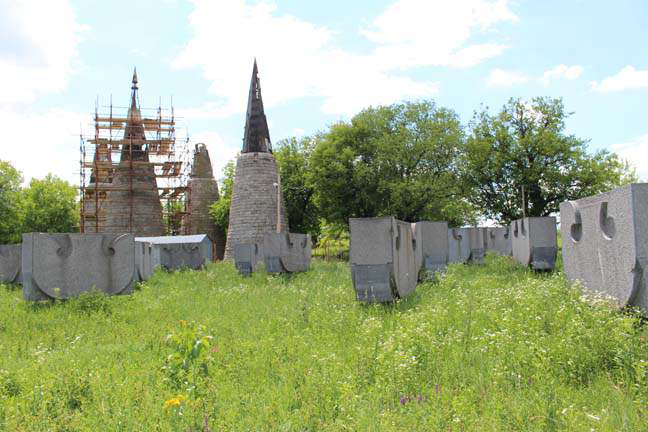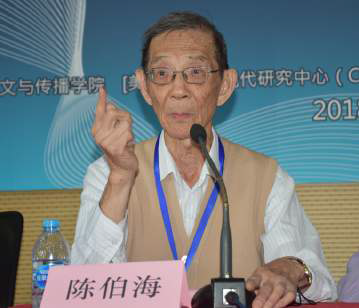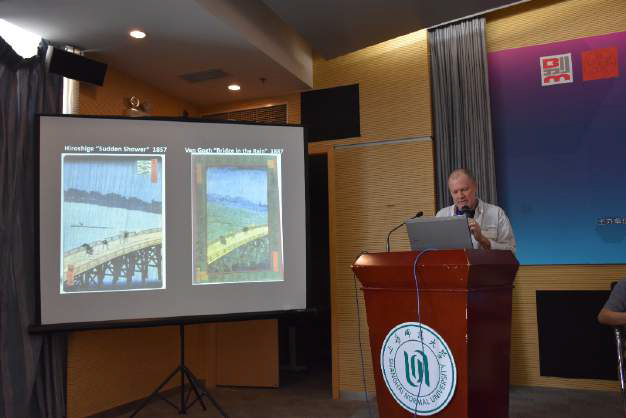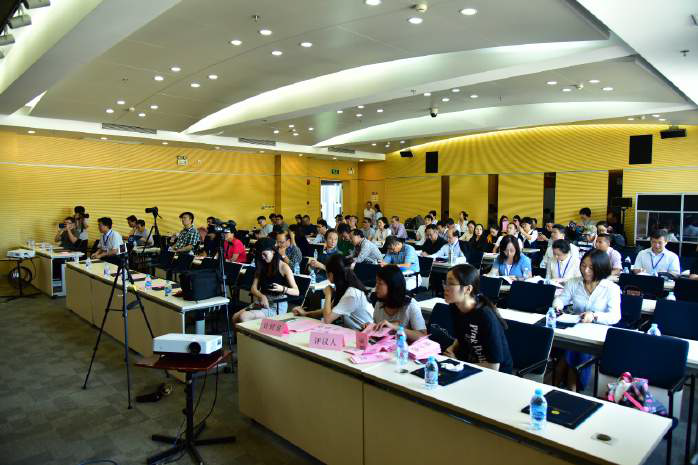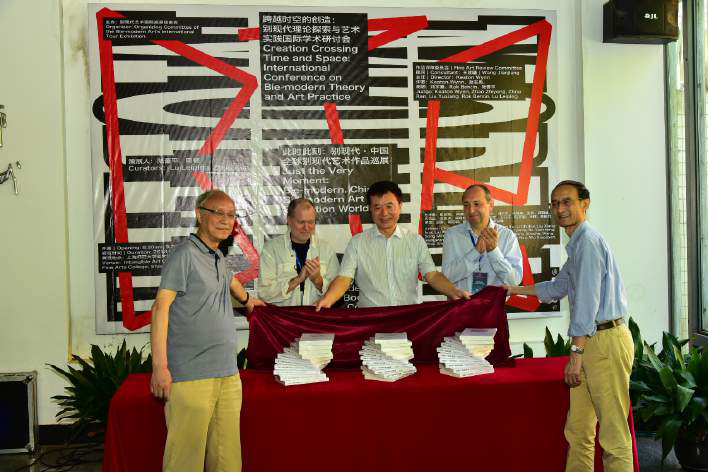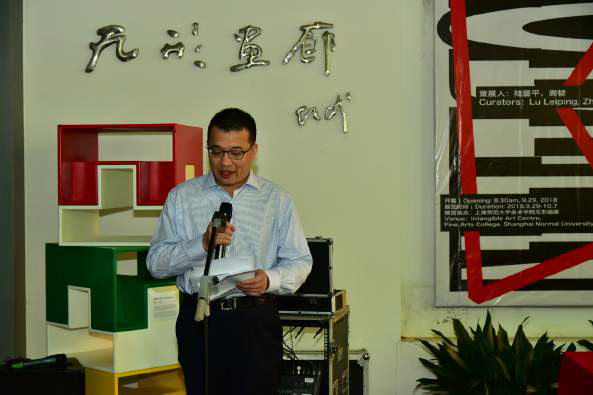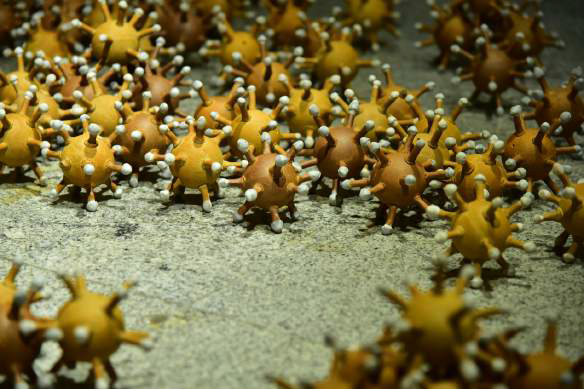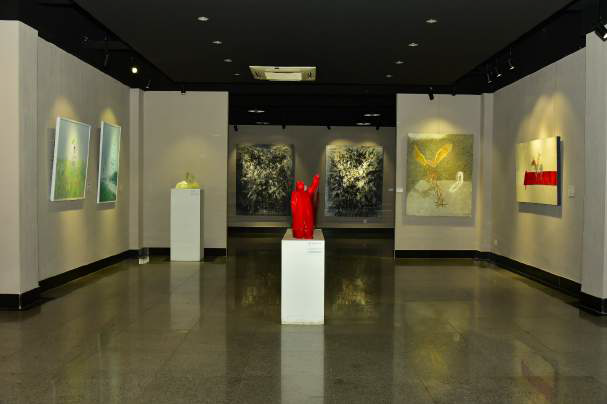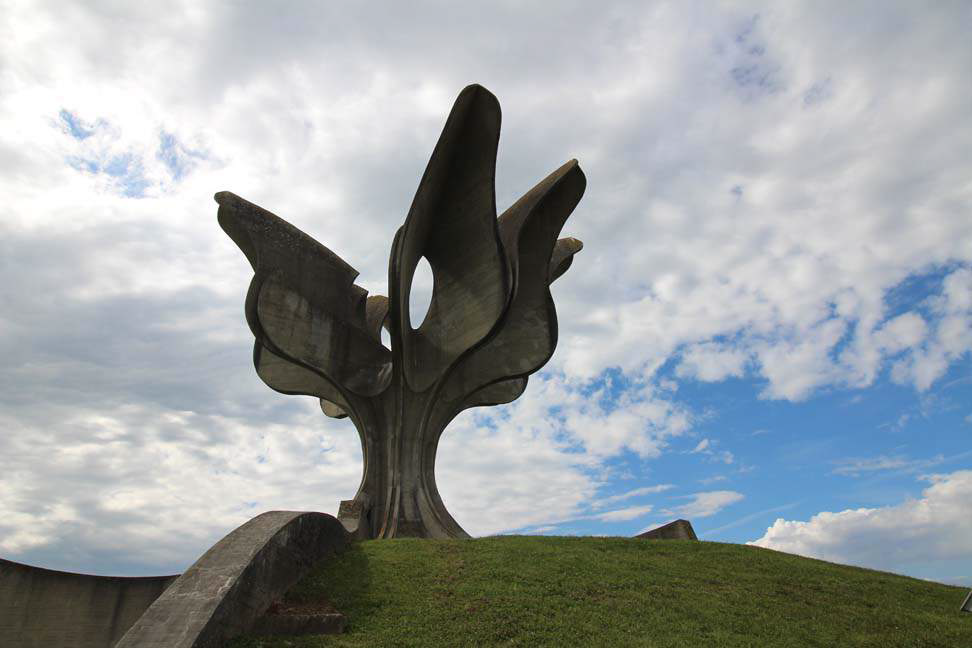Possible Worlds of Contemporary Aesthetics:
Aesthetics between History, Geography and Media
The University of Belgrade – Faculty of Architecture and the Society for Aesthetics ofArchitecture and Visual Arts Serbia (DEAVUS) present the 21st International Congress of Aesthetics 2019: Possible Worlds of Contemporary Aesthetics: Aesthetics between History, Geography and Media. Early registration and submission of abstracts is currently in progress.
http://iaaesthetics.org/item/172-ica-2019-belgrade-serbia-22-26-july-2019
Important dates
- Paper Submission due: February 28th, 2019.
- Pre-Registration: March 30th, 2019.
- On-site registration: July 22-26, 2019.
Conference Report
Creation Crossing Time and Space: International Conference on Bie-modern1 Theory and Art Practice, Shanghai, China
Reported by Cui Lushi, Master Zhang Shaowei. Translated by Lu Chunyi
Creation Crossing Time and Space: International Conference on Bie-modern Theory and Art Practice was closed in the international conference center of Shanghai Normal University on the day before the National Day. The two-day conference was jointly hosted by the School of Humanities and Communication of Shanghai Normal University, the Center for Chinese Biemodern
Studies of Georgia Southwestern State University(CCBMS), the School of Fine Arts of Shanghai Normal University, the Institute of Aesthetics and Aesthetical Education of Shanghai Normal University, and the China Social Science Press. On the 28th of September, nearly one hundred philosophers, estheticians, artists and art critics from home and abroad had a heated discussion on the Bie-modern theory. The conference covered three parts, namely the study of the Bie-modern theory, the exchange of experience of Bie-modern writing and the first exhibition of the international exhibition tour of Bie-modern arts. It was accompanied by At the Moment: Bie-modern China——the first exhibition of the international exhibition tour of Biemodern art, and the publication of Bie-modern book series, including Bie-modern: Space Encounters and Times Spans, Bie-modern: Discourse Innovation and International Academic Dialogue and Bie-modern: Works and Commentary.
The conference closely focused on the word Bie-modern. A total of more than eighty Chinese and English thematic papers about Bie-modern issues was collected. The conference was divided into eleven sessions, including the international frontier dialogues about the Biemodern theory, the exploration of the Bie-modern theory and the contemporary art theory, the Bie-modern theory and its evaluation, the Bie-modern theory and the literary theory, the philosophy and aesthetics of Bie-modernization, Bie-modern and artificial intelligence, Biemodern space and historical creation, Bie-modern and the construction of cultural industry and art market, Bie-modern and the film and television art, Bie-modern: China and the world, Biemodern publication and writing communication.
The first speaker was the former president of the International Artists Association, the renowned esthetician Aleš Erjavec. In his article Opening Words During the Presentation of the Book, he used the French philosopher Jacques Rancière as the reference. He said, perhaps another aesthetic Napoleon is on his way who will turn upside down the edifice of aesthetics, philosophy and the humanities. His words raised the expectations of the audience. American art historian Keaton Wynn gave many examples in his article Eurocentric Assumptions and the Misinterpretation of Bie-modern Art to criticize eurocentrism and the plagiarism and exclusion of non-western art caused by it. He strongly defended the originality of the Chinese Bie-modern art which was criticized by American critics. Professor Chenbohai’s article Questioning on the Bie-modern led people into questioning and thinking. Moreover, Professor Xiejinliang pushed the conference to a climax by his article Where Should Bie-modern Go: A Preliminary Study on Bie-modern theory of Wangjianjiang.
Professor Ernest Ženko, from Primorska University of Slovenia.
In the following speeches, the delegates compared modern, pre-modern, post-modern and bie-modern, and expressed some new and profound ideas. In the article Contemporary Art in the Context of Bie-modern Theory, philosopher Ernest Ženko concluded that even though the theory of Bie-modern has been developed to be used in specific Chinese context, its potential reach, at least regarding aesthetics and art, was undoubtedly much broader and consequently even more important. In the article Bie-modernity and Its Original Opportunity With Chinese Academics, Professor Wangxiaohua compared Wangjianjiang’s Bie-modern theory with Wanghui’s antimodern modernity. He criticized that Wanghui’s theory was isolated from reality while affirmed the construction of Bie-modern theory. In the meanwhile, he pointed out the realistic choice and the possibility of further development of Bie-modern theory. Professor Wanghongyue started from the comparison of Bie-modern and other modernities. He indicated not only their connections but also the fundamental differences. In the speech, Wanghongyue said that Wangjianjiang came to the post-modern Shanghai from the pre-modern northwest of China. The crossing of time and space made him create Bie-modern theory. This theory was created in the connection and collision between reality and history, China and the west, the west and the east of China. It was both experiential and well-grounded. His words set everyone laughing and applauding.
Starting from the study of the history of thought, speakers elaborated on Bie-modern philosophy and the generative mechanism from the perspectives of ontology, epistemology and methodology. Professor Daidengyun’s article How Can a New Narration of Total History Be Possible, Professor Liushengpeng’s article Westernization or Mutual Interpretation of Concepts: The Path of the Generation of Chinese Modernity, Professor Jianshengyu’s article Reflective
Exploration Under the New Pattern of Global Theoretical Dialogue: A Comment on Wangjianjiang’s Bie-modern Theory, Adjunct Professor Xiaominghua’s article Bie-modern: Entering Into History in the Dialogue of Intellectual History, Adjunct Professor Kangyong’s article Mythological Hero Narration and the Spatialization of Time expounded the development history and the inevitability of Bie-modern. They considered that as the basis of Bie-modern philosophy, the time spatialization theory was native and global.
Professor Li Ping, Shanghai Normal University, addresses the opening ceremony
on the exhibition of the international exhibition tour of Bie-modern art.
In the discussion of Bie-modern aesthetics, Zhangliqun, Xudawei, Wangweiyu, Guanyu, Zhao Shihua, Zhang Shaowei and other scholars discussed the inheritance and innovation, the category system, the philosophical origin and the modernity of Bie-modern aesthetics. In the discussion of Bie-modern and the film and television art, Professor Lidan and Adjunct Professor Zhouren started with the famous films at home and abroad over the past thirty years. They deeply analyzed the Bie-modern issues and the transformation of time and spaces in these films, and also the choices facing Chinese films in the Bie-modern time. In the discussion of the connection with Bie-modern and artificial intelligence, Professor Taoqing’s article Argumentation on Instrumentality and Sociality for Robo-sapiens - The First Robot Citizen of the World in the Perspective of Genetic Epistemology, and Ph.D. student Pengkai’s article The Reality Basis and Universality of Bie-modern Theory in the Technological Background Such as AI echoed the Bie-human theory and the life stock2 theory recently proposed by Wangjianjiang from the perspective of artificial intelligence. Artist Liuxianghua combined his speech with his exhibition pieces to analyze the foreign meaning of Bie-modern and its possibility of being a creation method. Artist Mengyan’s article The Creation, Docking and Application of Bie-modern art into Fennan Rural Revitalization showed the application prospect of Bie-modern in the perspective of cultural construction. Dr. Hubenxiong connected the concept of "imprinting" in ancient painting and calligraphy to explain Bie-modern art in a new way. Lihuaxiu included Yaoliyong’s simulacra painting into Biemodern art system. Professor Luleiping, the curator, delivered her speech At the Moment: the
Real Presence of Bie-modern Art to explain the curatorial idea of the first exhibition of the international exhibition tour of Bie-modern art and the philosophical thinking of Bie-modern art. International lawyer Yuguangrong’s article Warning Review and Response of Frequent Art Fraud Cases subtly echoed this first exhibition.
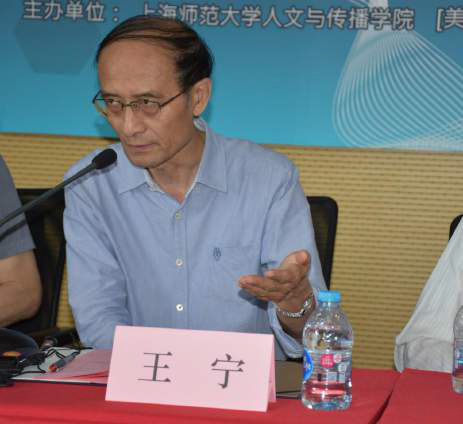 Professor Wang Ning, from Tsinghua University.
Professor Wang Ning, from Tsinghua University.
Adjunct Professor Jixiumei’s article The Enlightenment of Bie-modern Innovation to Creative Innovation and Creative Thinking Training of Chinese Writing in Colleges and Universities interpreted the word Bie based on the principle of parataxis in Chinese word formation. She believed that the literal meaning and the extended meaning of the word Bie in Bie-modern were closely connected, which could fully express the reality that Chinese modernity was still under development. Moreover, the difference between Bie-modern, Biemodernity, Bie-modernism, alternative modernity and other modernity was distinctive. As an academic term, Bie-modern was irreplaceable.
Caitlin Adair Daglis, a graduate student of American art history, showed in her speech Why Study Bie-modern Theory the reason why American graduate students should study Bie-modern theory. She also mentioned the understanding of international academic and cultural significance of Bie-modern theory, and the tendency of American students to attach importance to innovative ideas from outside the United States.
Professor Chen Bohai, Shanghai Academy of Social Sciences.
At the closing ceremony of the conference, Professor Wang Jianjiang, the founder of Biemodern theory, summarized and responded to all the speeches with his debating opponent Professor Wanghongyue from Zhejiang Normal University. Firstly, Professor Wangjianjiang believed this academic conference was very broad in the topic area. All the speeches were closely related to the Bie-modern theory. However, they also related to more than eleven special topics, including Bie-modern theory and evaluation, Bie-modern aesthetics and philosophy, Biemodern and contemporary art practice, Bie-modern and genre art, Bie-modern and contemporary China, Bie-modern and the world. Secondly, it was a profound meeting which involved some cutting-edge issues such as Bie-modern philosophy ontology and methodology, Bie-modern civilization morphology, and Bie-modern history genetics. Finally, this conference was a model of the successful combination of aesthetics and art. As the curator Luleiping said, in contemporary China, though aesthetics and art were literally similar, they had for a long time been unable to communicate with each other. The successful holding of this international conference, especially the successful exhibition of At the Moment: Bie-modern China, broke through the history of the separation of Chinese aesthetics and fine arts, and had important academic significance and artistic value.
After the concluding remark, Professor Wang Jianjiang gave another speech named The Biemodern: Where Is It Going as a general answer to the questions put forward by scholars in the past two days, especially the "where to go" question by Professor Xiejinliang from Fudan University. These responses, based on his article on the WeChat Official Account since August, further indicated the self-renewal, the self-transcendence and cashing life stock of Biemodernism.
Professor Wang Jianjiang, the founder of Bie-modern theory.
Finally, Keaton Wynn , the director of the Center for Chinese Bie-modern Studies of Georgia Southwestern State University (CCBMS) and professor of art history of Georgia Southwestern State University, looked to the future development of Bie-modern theory and art practice. He said that before the establishment of the Center for Chinese Bie-modern Studies in America, western scholars tried to solve the difficulties and problems existing between China and the west. However, westerners were good speakers but not good listeners. The establishment of this center was an attempt to change this situation. He came to the conference to listen. This conference was a good place for the development and expression of ideas. He hoped that in the future, American universities could invite Chinese scholars to visit and study a specific issue, just like what CCMBS did. It would provide a platform for the exchange between China and the west, so as to achieve the smooth progress of communication and promote the development of Bie-modern theory through mutual support and exchanges.
Keaton Wynn , the director of the Center for Chinese Bie-modern Studies at
Georgia Southwestern State University (CCBMS) and professor of art history,
Georgia Southwestern State University
The publication of Bie-modern book series, including
Bie-modern: Space Encounters and Times Spans,
Bie-modern: Discourse Innovation and International Academic Dialogue and
Bie-modern: Works and Commentary.
Chen Heng, vice-president of Shanghai Normal University.
Opening speech on the exhibition of
the international exhibition tour of Bie-modern art.
Meng Yan, an artist of Bie-modern.
Conference Report
The 4thForum on Chinese Leisure Philosophy and Soma-esthetics Opened in Jiangxi Province The 4th Forum on Leisure Philosophy and Soma-esthetics was held In Bailudong (White Deer Cave) Academy in Jiujiang, Jiangxi Province on July 23-25, 2018. This conference was cosponsored by Asian-Pacific Leisure Education Research Center of Zhejiang University, Somaesthetics Research Institute of Shenzhen University, School of Literature and Media of Jiujiang College and Central-China Leisure Culture Research Center of Hubei Polytechnic College. Over 40 Participants attended the conference, among whom are prominent Chinese scholars in the fields of Leisure Studies, Soma-esthetics and Ecocriticism, including Professor Yao Wenfang, Professor Pan Liyong, Professor Wang Xiaohua, Professor Yi-min Huang, Professor Song Lili and Professor Liu Bei.
As two rapidly developing academic fields, Leisure Philosophy and Soma-esthetics have attracted great attention in Chinese academic circles. Deeper exploration revealed the internal connections of the two: The leisure activities have been advanced to the cultural phenomenon as the consciousness on the physical body have been raised in the context of modernity and postmodernity. Consequently, the philosophical study on leisure philosophy promoted the construction of soma-esthetics. In order to reveal the interdisciplinariness of the research, the organizers decided to open this forum, which received positive response from many scholars with relevant academic interests. During two days of intense discussions and spontaneous dialogues, scholars from Zhejiang University, Shenzhen University, Tsinghua University, Shandong Normal University, Taking University and other universities represented their ideas on the construction of leisure philosophy in the perspectives of soma-esthetics, involving diverse fields including eco-aesthetics, studies of everyday life, life aesthetics, and traditional aesthetics. The interdisciplinary discussions also reflected the striking features of contemporary Chinese
aesthetics.
Conference Report
Submitted by co-organizers Lars Aagaard-Mogensen, Wassard Elea and Jane Forsey,
Department of Philosophy, University of Winnipeg.
Taste, Bad Taste and Tastelessness
May 25 – 28, 2018, Ascea, Italy
Wassard Elea, a refugium for artists and scholars, held its VIIIth International
Symposium in Ascea, Italy this year, dedicated to a conceptual analysis of the concept of taste. Taken as a common sense notion, almost everyone thinks that they have taste – indeed, thinks that they have good taste – in such things as art, music, dress, design, cuisine, and so on. But can we make sense of the idea that at least some of them may also be wrong? Frank Sibley described taste as an ability involving perceptiveness, sensitivity, aesthetic discrimination, and appreciation, and further noted that taste “is a somewhat more rare capacity than other human capacities”; relativists and sceptics would dispute this, and argue that taste is little more than liking, or preferring, some things over others, and that its phenomenology is essentially private and subjective. Both positions (and those in between) involve complex epistemological, ontological and phenomenological questions, which participants were tasked to explore. Our invitation attracted an international slate of scholars, from Sweden, Slovakia, Denmark, Italy, the UK, Canada, and the United States, whose approaches to the topic were equally as diverse. Over two and a half days of intensive sessions, presentations included those arguing for a relativist conception of taste, those suggesting that taste provides a privileged access to truth and knowledge, those who considered the moral ramifications of taste in education and cultural conflict, as well as papers that concentrated on the phenomenology and science of gustatory flavour sensations. As our remit was to move beyond rehearsals of well-trodden Kantian or Humean philosophies of taste on the one hand, or sociological studies like those of Bourdieu on the other, we were rewarded with truly innovative and contemporary works that explored the notion of taste in sometimes surprising ways. One paper argued that digital media has made the relation between form and function in design arbitrary, affecting the basic criteria for judgements of taste; another that flavour sensations are intrinsically valenced and temporal such that no two people can actually taste the same flavour in a food. While some argued that taste is indeed a capacity that can be trained, an opposing view suggested that taste is in fact the confrontation of the impossibility of discernment altogether.
Participants voiced appreciation at the novel format at Wassard Elea: longer sessions for detailed presentations of 40 minutes, with each participant also providing a 20 minute commentary on another paper. This arrangement encouraged an intimate and engaged atmosphere of discussion and the exchange of ideas. The organizers would like to thank all those who submitted papers, and the contributors themselves for what we hope was a fruitful and successful meeting. Papers and their commentaries are published in Wassard Elea Rivista, V, no.4, VI, nos. 1 and 2, (2018) and VI no. 3 (forthcoming). Wassard Elea Rivista is indexed in the Italian National Bibliography.
Conference Report
The 4thForum on Chinese Leisure Philosophy and Soma-esthetics Opened in Jiangxi Province The 4th Forum on Leisure Philosophy and Soma-esthetics was held In Bailudong (White Deer Cave) Academy in Jiujiang, Jiangxi Province on July 23-25, 2018. This conference was cosponsored by Asian-Pacific Leisure Education Research Center of Zhejiang University, Somaesthetics Research Institute of Shenzhen University, School of Literature and Media of Jiujiang College and Central-China Leisure Culture Research Center of Hubei Polytechnic College. Over 40 Participants attended the conference, among whom are prominent Chinese scholars in the fields of Leisure Studies, Soma-esthetics and Ecocriticism, including Professor Yao Wenfang, Professor Pan Liyong, Professor Wang Xiaohua, Professor Yi-min Huang, Professor Song Lili and Professor Liu Bei.
As two rapidly developing academic fields, Leisure Philosophy and Soma-esthetics have attracted great attention in Chinese academic circles. Deeper exploration revealed the internal connections of the two: The leisure activities have been advanced to the cultural phenomenon as the consciousness on the physical body have been raised in the context of modernity and postmodernity. Consequently, the philosophical study on leisure philosophy promoted the construction of soma-esthetics. In order to reveal the interdisciplinariness of the research, the organizers decided to open this forum, which received positive response from many scholars with relevant academic interests. During two days of intense discussions and spontaneous dialogues, scholars from Zhejiang University, Shenzhen University, Tsinghua University, Shandong Normal University, Tamkang University and other universities represented their ideas on the construction of leisure philosophy in the perspectives of soma-esthetics, involving diverse fields including eco-aesthetics, studies of everyday life, life aesthetics, and traditional aesthetics. The interdisciplinary discussions also reflected the striking features of contemporary Chinese aesthetics.
Member Society Report
By Georgia Apostolopoulou
Delegate of the Hellenic Society for Aesthetics
The Hellenic Society for Aesthetics organized a ceremony on June 8, 2018 that was hosted in the Exhibition and Events Hall of the Panayotis and Effie Michelis Foundation. The programme was as follows:
1) Lectures (in Greek).
Catherine Dimitsantou-Kremezi, Professor Emeritus of the National Technical University: Dionysis Zivas (1928-2018), Honorary President of the Hellenic Society for Aesthetics: His Contribution to Education, Architecture, and Aesthetics. Maro Kardamitsi-Adami, Professor Emeritus of the National Technical University: Panagis Psomopoulos (1926-2017), Architect, Director of the journal “Ekistics”: His Contribution to Ekistics and Urbanism.
Georgia Apostolopoulou, Professor Emeritus of the University of Ioannina: Dina Peppa-Delmouzou (1925-2018), Director of the Epigraphic Museum of Athens: Her Contribution to Epigraphy and to the History of Culture.
2) Award of the title of Honorary Member of the Hellenic Society for Aesthetics. The title of Honorary Member was awarded to the following founding / distinguished senior members of the Hellenic Society for Aesthetics: Dimitris Andriopoulos, Linos Benakis, Dimitris Fatouros, George Ioannidis, Evanghelos Moutsopoulos, Nikolaos Moutsopoulos, Tereza Pentzopoulou-Valala, Catherine Spetsieri-Breschi.
The Hellenic Society for Aesthetics organizes lectures hosted in the Exhibition and Events Hall of the Panayotis and Effie Michelis Foundation. The following lecture (in Greek) was delivered on October 10, 2018: Niki-Chara Banakou-Karagouni, Former Associate Professor of the National and Kapodistrian University of Athens:
Paul Valéry: Theoretical Quests and Poetic Creation.
Doctoral Dissertation Defense by Alan Shear
Delivered: October 17, 2018 at the Postgraduate Research Center, Academy of Science and Arts (ZRC SAZU), Ljubljana, Slovenia.
Remembering Sculpture: The Philosophy of Martin Heidegger and the Commemorative Sculptures of Bogdan Bogdanović
by Alan J. Shear
This dissertation investigates four seminal ideas infused throughout the written works of German philosopher Martin Heidegger to demonstrate how these ideas can inform an interpretive method that can be applied to the commemorative sculptures of Bogdan Bogdanović. Among these ideas is Heidegger’s attempt to overcome the eclipse of Being in metaphysics since Plato. Secondly, from this recovery of Being is then rethinking what it means to be human or Dasein in Heidegger’s parlance. Dasein, being-there, refers to individual human beings but not as subject or object, not as a discrete substance with attributes, but rather being-there as a gathering of relationships. Thirdly, the fundamental nature of Dasein’s gathering is dwelling and our most fundamental relationship as dwelling Dasein is being-toward-death. Fourthly, the idea of the fourfold describes the character of Dasein’s dwelling as being-toward-death. The Fourfold’s dynamic relationships: saving the earth, receiving the sky, awaiting the divinities and initiating our own mortality. The fourfold describes Dasein’s constitutive relationships. They are neither independent objects nor representations of four separate ideas. The dissertation demonstrates how Bogdanović’s commemorative sculptures exemplify these Heideggerian ideas. It is how Dasein dwells in the Fourfold as being-toward-death that will provide the foundation from which to offer a Heideggerian interpretation of Bogdanović’s commemorative sculptures.
Heidegger’s project in The Origin of the Work of Art is, in part, an attempt to recover a pre-Socratic ontology that he extrapolates from Parmenides, and concomitant with this attempt, to explore the origin and nature of art. In describing Platonism as the tradition that defines things as bearing properties, Heidegger includes also metaphysical definitions by Aristotle, a substance is the unity of form and matter, and Kant, a substance is the unity of the manifold of what is given to the senses.3 In The Origin of the Work of Art Heidegger selects Poseidonia’s temples as contemporary with Parmenides examples to explore how these Doric structures were not thought of by their builders and pilgrims as formed matter, substances bearing characteristics, or a collection of sense-data. So, if this is what the temples were not understood within a Platonic metaphysics how then can we think of them? In Heidegger’s Parmenideanism the temple gathers the indwelling presence of the deity but presence is neither habitation, nor residence, nor incarnation. The temple is the dwelling place of the gods in the sense that it is the place where they fulfill their role of looking through things. The temple gathers dwelling. The temple gathers sight. The sight of the temple is not that it is seen but rather that it presents itself to our sight. It emerges into presence, it cannot be concealed from Dasein’s experience.
This Parmenidean metaphysics of Poseidonia’s temples demonstrate how this architecture was the unconcealing of truth. This interpretation of Doric architecture facilitates what Heidegger refers to as the work of the artwork: it works by bringing forth, clearing away, and making appear. The dissertation demonstrates how Bogdanović’s commemorative sculptures exemplify these aspects of Heidegger’s Parmenidean philosophy. The pilgrim processes along the pathway arriving within a collection of arranged standing stones where the eclipsing metaphysics of duality and separateness fades as they stand amidst the gathering complex of stones. There is no objective viewer standing in front of a single carving. Bogdanović created commemorative environments that are spread out in time and space. The sculpted stones standing in their sculpted landscape resist representation. Bogdanović said, “That is the beautiful part of making open forms, using open symbols. The symbols are in principle something very open, something which is very lively, never fixed. When somebody asks what a symbol is meaning, what it is trying to say, that is always the wrong question to ask.”4 Both Bogdanović and Heidegger posit that what we build is a kind of text that is experienced at a deeper level of human consciousness; primal, before duality. For Heidegger, Dasein’s being-toward-death consciousness is thinking-back carefully. Heidegger states that “Temporality reveals itself as the meaning of authentic care.”5 Temporality is undisclosed in that are aware that we live and die. Our self-understanding of our limited life span constitutes the mode of our being-in-the-world, that is, this understanding of the importance of how we live and how we die is the meaning of care. Heidegger’s concept of caring is what Dasein gathers while experiencing Bogdanović’s sculptures in their landscaped place of commemorative thought. Heidegger states: “Finitude is not some property that is merely attached to us, but is our fundamental way of being. If we wish to become what we are, we cannot abandon this finitude or deceive ourselves about it, but must safeguard it. Such preservation is the innermost process of our being finite, i.e. it is our innermost becoming finite.
Vukovar, Croatia: Dudik Memorial Park for the Victims of Fascism (1978-80).
* All photographs by the author.
Dwelling constitutes the fundamental manner in which we are mortal and our mortality is expressed when we built. Dwelling and building gather the fourfold and for Heidegger, earth and sky, divinities and mortals, gather in the opening which the built thing creates. The fourfold inheres in the built thing and the place that is gathered is preserved by Dasein. All these relationship are essential to Dasein. The manner of Dasein’s dwelling is preserving the fourfold. Preserving is an authentic manner of our being in the world. Authenticity is both a kind of understanding and a kind of remembering. The relationship between understanding and remembering Heidegger calls thinking-back, or Andenken. The dissertation shows how Bogdanović’s sculptures gather Andenken by providing a place for gathering remembrance and of what is to be remembered through the place. Bogdanović’s commemorative sculptures gather historicity, that is, a worldview that changes over time. Heidegger would say that the memorials sculptures in their landscaped clearing gather the conditions for the possibility of remembering. Bogdanović created places where the work of the art work gathers, that is, it facilitates Dasein’s remembering. Remembering is gathering and Dasein dwells in the between.
The dissertation argues that one of the results of Heidegger’s attempt to recover Parmenidean pre-metaphysics is how this recovery transforms our understanding of what being human means. Platonic duality, is replaced by an understanding of Dasein as de-substantialized. Dasein is neither object nor subject, but an embodied confluence of relations that moves within its element. In Dasein, human beings are a gathering not an object in space. We are neither separate from the field of relations within which we live and move nor distinct from all the reciprocal interrelations that measure and limit Dasein as being-toward-death. Awareness of our own mortality surrounds Dasein. If we were a fish this self understanding would be the water we swim in. When Dasein as being-toward-death thinks about its own temporal limit, this apprehension of its being is neither subjective perception, nor is it represented in thought as an object. Dasein as being-toward-death is significant because this determination will provide the ground for understanding Heidegger’s philosophy of art so as to interpret Bogdanović’s memorial art works.
Bogdanović’s commemorative sculptures are aesthetic objects that intentionally narrate the meaning of a particular type of historical event, shared by different persons at different times and places. Even so, the sculptures are not so read because on Heidegger’s view commemorative sculptures are the embodied memory of an event. Bogdanović resisted a specific narratives, rather the place and the sculptures there gather remembering as a concern for the life and death of the victims and as a gathering place for pilgrims to think-back. Bogdanović’s sculptures are memorials, not monuments. They resist triumphalism because they commemorate the victims of lost battles rather than victories. No illustrious persons are heroically represented—only victims—and at most commemorative places they are unnamed. Nevertheless, for Heidegger and Bogdanović, commemorating death does not imply that the dead have become objects. Nor are the dead objectified. Bogdanović’s sculptures express the sacrificial condition of the deaths that occurred there while the ceremony is a handing down of the narrative of the historical context of their deaths. Bogdanović’s works provide the environment where Dasein preserves the art work for the person in a place with others that is both environmental but also expressive. The sculptures are encountered in a landscape that has been molded. The kind of stone and where it is placed are intentional, with the goal of integrating the participant into the landscaped environment of carved megaliths.
Heidegger’s Fourfold is integral to his Parmenidean discussion of relationships. Sheehan reminds us, “The relation of Dasein and clearing is not a bond stretched between them… The relation is the clearing itself. Dasein’s essence is that relation.”7 This view of relations permeates Heidegger’s philosophy, and here the discussion turns to the relation of preserving—ceremony. One of the ways that Dasein acts in preserving is ceremony. Ceremony is one of the ways the art work works. Ceremony is an art form that includes human presence in a specifically designed place where remembrance becomes manifest in words and actions. While ceremony has a theatrical aspect in its presentation, it is a distinctive form of art work, because Dasein thinks and understands commemoratively. The work of the work of art opens and clears a place for the setting-into-work to happen. The setting-into-work of truth in ceremonial art is “the bringing forth of the concealedness of what is. Setting-into-work, however, also means: the bringing of work-being into movement and happening.”8 The clearing of the place is where ceremony as an art form can occur, that is, gathered. Commemorative ceremony is the art of Andenken.
Heidegger description of Dasein’s encounter with art works, like sculptures or architecture, is to wander about within them so that dualism evaporates. Bogdanović’s commemorative environments include sculptures and the landscaped open space facilitating an embodied experience of the place and the remembrance that is undisclosed there. Each of the places researched for the dissertation encountered pathways through a landscape which surrounds bodies wherein the pilgrim becomes part of the commemorative environment. The processing ceremonialist walking to the ceremonial clearing sometimes encounters stones along the path which make the way appear. Bogdanović created a Parmenidean place where Dasein experience is not a contingent property but is rather being-there gathering relationships; standing in the clearing as a single unified phenomenon with the sculptures. The dissertation shows that in the pilgrims’ embodied experience of the place that the meaning of the place is expressed. As commemorative sculptures are experienced, they express a world-making symbol system, and as an expression they can be interpreted. The sculptures express meaning with no stable subject expressing or interpreting the expression of meaning. In this way, the sculptures are a nonnarrative expression of historical remembrance; not representing but gathering meanings to that place. It is in this way that the art work is not a just a built thing but is rather an event. Art is a when, and in the case of Bogdanović’s memorial sculptures, the what and where is a when. They are architecture as event.
Bogdanović’s sculptures present a novel form of commemoration, recognizable even as its structural elements defy the traditional form of memorial. One interpretation is that they represent a sculptural analog of a foreign language of which the hearer has some vague recognition of the sound of the words from the manner in which they are spoken, but not their full meaning. Standing there in the place of Bogdanović’s commemorative sculptures, Dasein remembers its own finiteness. Bogdanović’s commemorative sculptures are the element through which the pilgrim moves in relation to the sculpted stones, neither the conquest of space, nor the procurement of information, but rather a non-technological looking through, the free play of the imagination as Dasein living with death. Dasein gathers mortality in relation to our own finitude. Andenken is to think again, which is a way of understanding, of dwelling in such a way that we remember how we are rooted in place. In this way place gathers Andenken, to think-again preserves memory. As Heidegger says, “Memory is the gathering of thought”. One form of thinking-back is ceremony, and Andenken is inaugurated by ceremonial action at Bogdanović’s commemorative environments. Andenken in that place is an encounter with the self that shatters the ordinary while recovering Dasein’s deepest Being. While temples and bridges gather one kind of Andenken, commemorative sculptures gather another kind; not a particular personal memory, but rather, it is a return to the origin of Dasein as being-toward-death: “Remembrance attaches thinkers to their essential ground.”9 The event of sculpture and place are the vehicle through which the remembering is gathered. Ceremonial Andenken is commemorative thought expressive of Dasein’s being-toward-death within a particular historical context. Bogdanović’s sculptures are places purposely designed for ceremonial Andenken
Jasenovac, Croatia: Memorial to the Victims of the Concentration Camp (1966).
On Heidegger’s view, Bogdanović’s sculptures are not first of all thought of as discrete objects with properties. They are places that gather Dasein’s fundamental essence as beingtoward-death. The sculptures are not reminders because they are non-representational, both in the artistic sense as abstract art forms and in the Platonic sense as has been discussed. Bogdanović created places where the metaphysical separations of place, body and memory dissolve. The sculptures gather remembering. Even as commemorabilia the sculptures in their landscape are not reminders, nor do their descriptive labels represent personal memory. Bogdanović’s sculptures gather the Andenken of what is to be remembered through the place. It is Dasein’s Andenken as participation in shared ceremony at a place and time that demonstrates how Heidegger’s Parmenideanism gathers at Bogdanović’s sculptures. Also, the dissertation describe how events gather interpretations, and in a Parmenidean context, there is no one true interpretation, even when the label of the commemorative event and the site are identical. Gathering describes a relationship. Bogdanović’s commemorative sculptures stand at the confluence of place and event. Architecture, which includes sculpture, is a kind of event in that it shares the place where some action occurred.
Dasein is always being-toward-death and so there is reciprocity of interpretation regarding how one dies and how one has lived. In other words, there are two narratives: of our life as resume and of our death as eulogy. Eulogy as a description of the manner of one’s death is thought of as retroactively influencing the interpretation of how one lived. In other words, a good death is then a good life. How one dies has some meaning for those who remember it, but more importantly it is meaningful because of the choice to live and die. The dissertation demonstrates how Heidegger’s philosophy of how the life of Dasein is expressed in death provides the criteria for the interpretation and critique of Bogdanović’s art works.
Bogdanović’s sculptures are not, within Heidegger’s Parmenidean worldview, representative objects. Death is not represented in the sculptures, nor is the human being. Standing amidst Bogdanović’s sculptured stones commemoration as a way of thinking ignores representational conceptualization. In the arrangement of the sculpted stones in the sculpted landscape, Bogdanović’s work gathers relationality. The pilgrim is a relational gathering amidst phenomenal appearing, as each site engenders a variety of experiences and remembrance. Heidegger states that the art work’s work clears a place, in the act of clearing the work gathers.
Sculpted stones in a place gather narratives. The meaning of the event is expressed in the sculptures and the sculptures identify what the narrative means. Nevertheless, the meaning of the narrative is not identity. The dissertation posits that identity is not sameness, for the commemorated event narrated in sculptures expresses a general meaning. Place is not identical with site. The site of the event is not identical with the place that remembers. Bogdanović’s commemorative sculptures express a narrative without a subject. The sculptures are experienced by pilgrims as expressing diverse meanings. As was intended by Bogdanović, the sculptures may not be experienced as commemorative at all, but rather as playthings to climb upon or as a place for socializing. Even when the narrative is particular and the remembering pilgrim identifies the place with the event, their interpretation of the meaning of the label for that place is diverse. These labels of the commemorative sculptures connect place with event without needing to relate either of these to Bogdanović. The label of the site is the only text that elucidates the commemorative aspect of the place and determines how and what is to be remembered. These places gather both narrative and performance. The event as architecture and ceremony is a cultural expression. Commemorative places gather ceremony. Sculpture and landscape are in a symbiotic relationship, from which the remembering is gathered.
Leskovac, Serbia: Memorial to the Revolution (1964-71).
Within the Parmenidean perspective, while the sculptures are physical objects and their materiality expresses meaning, it does not necessarily follow that they can only be interpreted according to the metaphysics of the tradition. Bogdanović’s sculptures within Platonism are construed as a kind of human utterance expressive of intention of the artist and as such possess a property of identity for which there is one true interpretation. Joseph Margolis thinks Heidegger disagrees with this as neither artist nor their intention is, “reducible to the conditions of the individuation and identity of the entities in which they are embodied.”10 For Heidegger, Dasein is a gathering, not an object. So also the art work. The place of Bogdanović’s sculptures gathers an intertwining relationship between culture, history and pilgrims at a particular place. The reciprocity between the sculpted landscape and sculpted stones is an event. An event is where meaning occurs. Meaningfulness is the experience of Dasein’s being-there. The ‘where’ or ‘there’ is the place of the event. Building commemorative sculptures at the place of an event, or as a symbol for a kind of event, provides narrative continuity, a handing down of meaning from the original event to the commemorator, the pilgrim. Each sculpture is a kind of narrative, but Bogdanović’s Parmenideanism is such that the sculptures do not express a singular identity.
In conclusion, even as Bogdanović’s sculptures are a particular destination this destination is simultaneous with walking the pathway that eventually arrives at the concentration of sculptures. The commemorative sites are mostly not a single standing form, but an arrangement of multiple stones across a sculpted landscape. When pilgrim Dasein completes their processional walk along the sculptured path, they arrive into the open place where they stand among and within the sculpture. It is the clearing that gathers aletheia, unconcealment, in order that Dasein may think again the fundamental human essence. The stones in the landscape create the place. On Heidegger’s view, Bogdanović’s commemorative landscapes restore visuality where seeing and seer unite. The pathways provide the pilgrim with time to think-back, to think-again as they walk the path of remembering sculpture.
Vlastonice, Serbia: Shrine to the Fallen Freedom Fighters (1973-75).


